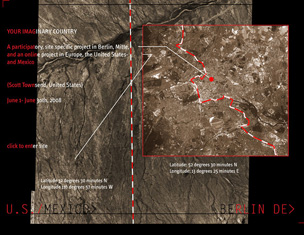Your Imaginary Country: the Berlin Wall and the Southwest United States
While the issues of national borders are site specific, some borders share similar issues.
Borders are intercultural areas where control, defense, and exclusion in regard to the "mother country" or "national character" are played out. "National defense" during the Cold War helped to define concepts and rhetoric of cultural identity.
The border between Mexico and the United States is one such inter-cultural area. The Berlin exhibition included maps comparing similarities between the U.S./Mexico border, and the recent history of East and West Berlin. After almost twenty years, Berlin is still a city in transition, seeking to find an identity that is common to both communities, while contending with a new influx of people from the EU and elsewhere. While the U.S. and Mexico and Germany might seem very different places, there are striking similarities (see: update on the "SBI" the Strategic Border Initiative, Jan 15 AP)
The exhibition, held in a gallery just north of Alexander Platz, utilized projected, interactive works shown in the gallery and also online, allowing audiences in Europe and the United States to participate. Broadsheets introduced six different themes or issues that frame the interactive work. A follow up exhibition occurred in Texas in 2010, with additional site-specific interactive work.
"Your Imaginary Country" uses portrait images tied to images of maps and globes. What is common to both political map and portraiture is the concept of identity.
The piece compares the issue of identity in terms of how we look at our opposites- using the metaphor of 'split hemispheres' (the split hemispheres of the globe, the 'split hemispheres' of personal identity: often seeing ourselves as being in a state of ambivalence (the conscious to the unconscious, irrational versus rational, self-destructive versus etc.). The piece attempts to show how the audience arbitrates being politically split in two through the evolving diagram of responses and through invited text submissions, which become part of the installation. During the installation, the interactive work gathers and displays audience input in the gallery space and online.
Answers:
- Elicit reflection and response based on the comparison of the two border areas.
- Ask specific questions of the audience about how they define national or cultural identity (language, national borders, their history, the context of how their identity gets played out, such as whether they repress themselves at work or in public, and what it is to be a member of a particular community in "private," etc.) and visually display the answers in the gallery space and also online.
- The concurrent website includes an online version of the maps plus the ability to participate in German or English.

